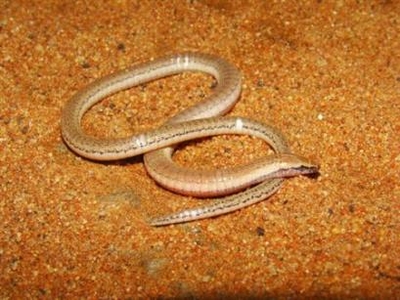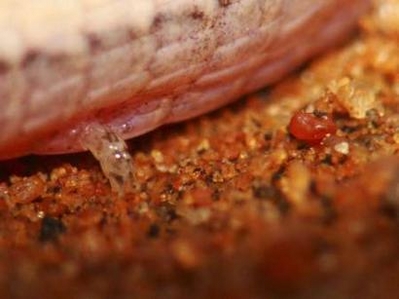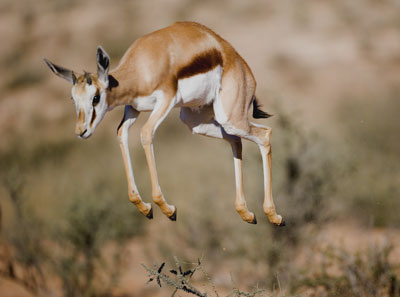Dead whale found in river, scientists puzzled
Young beluga was hundreds of miles from oceanFriday, June 16, 2006; Posted: 1:39 p.m. EDT (17:39 GMT)
ANCHORAGE, Alaska (AP) — Scientists are mystified by the carcass of a young beluga whale found in a river in central Alaska, nearly 1,000 miles from its natural ocean habitat.
The first guess is the 8-foot-long whale, which often feed on fish in estuaries and the mouths of rivers, swam away from the ocean in search of food.
“What are the alternatives?” asked Link Olson, a curator at the University of Alaska Museum of the North.
It was highly unlikely that someone was perpetrating a hoax along a remote section of river with a whale carcass, he said.
“If you were ever close to a dead marine mammal, even for a few hours, you would know why no one in their right mind would do that.”
Canoeists found the whale June 9 on the Tanana River about 40 miles southwest of Fairbanks.
Sylvia Brunner, a marine mammals researcher at the museum in Fairbanks, identified the decomposing carcass and oversaw its recovery on Wednesday.
The “bloated, black thing on the beach” was about 12 feet from the river’s edge, she said.
It could have died in the river last fall and frozen during the winter, Brunner said. On the other hand, the whale could have entered the river this spring seeking fish heading for the ocean.
“When you get a carcass like that, there are a lot of unanswered questions,” she said.
The carcass was taken to the museum, where it will be “cleaned and prepared as a full skull and skeleton and we will preserve tissue samples,” Olson said.
Belugas are toothed whales and belong to the same group as sperm whales, killer whales, dolphins, and porpoises, according to the Alaska Department of Fish and Game.
He's got those shrimpy eyes…

Weird Shrimp Has Astounding Vision
ScienceDaily (May 15, 2008) — A Swiss marine biologist and an Australian quantum physicist have found that a species of shrimp from the Great Barrier Reef, Australia, can see a world invisible to all other animals.
Dr Sonja Kleinlogel and Professor Andrew White have shown that mantis shrimp not only have the ability to see colours from the ultraviolet through to the infrared, but have optimal polarisation vision — a first for any animal and a capability that humanity has only achieved in the last decade using fast computer technology.
“The mantis shrimp is a delightfully weird beastie,” said Professor White, of the University of Queensland. “They’re multi-coloured, their genus and species names mean ‘mouth-feet’ and ‘genital-fingers’; they can move each eye independently, they see the world in 11 or 12 primary colours as opposed to our humble three, and now we find that this species can see a world invisible to the rest of us.”
Dr Kleinlogel, is based at the Max Planck Institute for Biophysics in Frankfurt, and collected the shrimp from the reef. She notes that, “…scuba divers know them as ‘thumb-splitters’, they’ve got wickedly strong claws and are very aggressive!”
Prehistoric crocodiles

Scientists Unveil Prehistoric “Sea Warrior” Crocodile
A fossil of a new prehistoric crocodile species “Guarinisuchus munizi” is seen during a press conference at National Museum of the Rio de Janeiro Federal University in Rio de Janeiro, Wednesday, March 26, 2008. Brazilian scientists say they have found a new prehistoric crocodile species that inhabited the Earth’s oceans some 62 million years ago.
(Ricardo Moraes/AP Photo)Pointy-nosed crocodiles may have joined sharks as the dominant predators in the world’s oceans some 62 million years ago, according to Brazilian scientists who on Wednesday unveiled one of the most complete skeletons found yet of the prehistoric animals.
Scientists called it a new species, “Guarinisuchus munizi,” and said it sheds new light on the evolutionary history of modern crocodiles.
The fossil includes a skull, jaw bone and vertebrae, making it one of the most complete examples of marine crocodylomorphs collected so far in South America, said Alexander Kellner of the National Museum of the Federal University of Rio de Janeiro. He and other scientists unveiled fossils and a model of the 10-foot-long crocodile at the museum.
“It’s a very rare find and it gives rise to several new theories,” said Kellner, who co-authored an article on the find that was published Tuesday in Proceedings of The Royal Society B, a London-based peer-reviewed journal.
Guarinisuchus appears to be closely related to marine crocodylomorphs found in Africa, which supports the hypothesis that the group originated in Africa and migrated to South America before spreading into the waters off the North American coast, Kellner said.
The find also suggests that marine crocodylomorphs replaced marine lizards during the early Paleocene era, about 65 million years ago — the same time marine lizards became extinct. They believe it’s a new species based on anatomical differences in the skull that are unique to this creature.
Philip Currie, a paleontology professor at the University of Alberta, Canada who was not involved with the discovery, said it was an important find.
“There are a lot of unknowns with this group in terms of evolution. Clearly the discovery of a specimen as nice as this one will help sort things out,” Currie said in telephone interview.
The bones were found in the northeastern state of Pernambuco. Scientists named the species “Guarinisuchus” after the Tupi Indian word “Guarani,” which means warrior and “munizi,” in honor of Brazilian paleontologist Deraldo da Costa Barros Muniz, who has discovered many dinosaur fossils off Brazil’s northeastern coast. Muniz didn’t participate in this find.
Scientists have discovered a wealth of crocodile ancestors around Brazil in recent years.
In January, they announced the discovery of an 80 million-year-old land-bound reptile described as a possible link between prehistoric and modern-day crocodiles.
Two years ago, paleontologists from the Federal University of Rio de Janeiro announced the discovery of a 70-million-year-old crocodile fossil that they called Uberabasuchus Terrificus, or “Terrible Crocodile of Uberaba.”
This “Terrible Crocodile of Uberaba” sounds interesting, so let’s dig up that story:

‘Terrible crocodile of Uberaba’ unveiled
Fossil offers look at Earth’s ecosystem of 70 million years ago
Thursday, February 17, 2005 Posted: 2109 GMT (0509 HKT)
RIO DE JANEIRO, Brazil (AP) — The discovery of a nearly intact fossil of a prehistoric crocodile is
teaching scientists what the world was like before the continents were separated by oceans, a Brazilian paleontologist said.
A reproduction of the previously unknown creature — dubbed Uberabasuchus terrificus, or the terrible crocodile of Uberaba, was unveiled Wednesday at the Federal University of Rio de Janeiro.
Uberabasuchus lived 70 million years ago and was smaller than today’s crocodiles — only about three meters (10 feet) long and weighing about 300 kilograms (650 pounds), said paleontologist Ismar de Souza Carvalho.
“It’s important because the fossil was extremely well preserved, with 85 percent of its skeleton practically complete and intact,” he said.
Carvalho said Uberabasuchus lived on land — it was named because the fossil was found near Uberaba, an inland city in southeastern Brazil. It probably carried its body high off the ground on sturdy legs and was a strong and voracious hunter, he said.
“We’re learning about a new species of crocodile, the ecosystem of 70 million years ago, and the evolution of the land crocodile on the ancient continent of Gondwana,” Carvalho said.
Scientists believe the continents then were joined in a huge land mass, which some call Gondwana. Fossils similar to Uberabasuchus have been found in Africa and in Antarctica, which possibly were linked to South America.
Despite some similarities with modern-day crocodiles, Uberabasuchus became extinct when the other great dinosaurs died out, and it has no relation to today’s crocodiles, Carvalho said.
Brazil has drawn international attention for its recent discoveries of prehistoric creatures.
In December, scientists unveiled a replica of Unaysaurus tolentinoi, an ancestor of the huge Brontosaurus, that lived 230 million years ago in what is now southern Brazil. Experts said it was more closely related to fossils found in Germany than to dinosaurs from neighboring Argentina.
Zootaxa, a scientific journal published in New Zealand, said Unaysaurus “differs from all other dinosaurs.”
Carvalho predicted there was more to come.
“Important new discoveries are practically certain,” he said.
Gazelles Shrink Heart to Beat Heat
Muhahahahahaha!
Bizarre Survival Tactic: Gazelles Shrink Heart to Beat Heat
By Bjorn Carey
LiveScience Staff Writer
posted: 08 June 2006
04:13 pm ETIn an extreme way to beat the heat, a sand gazelle shrinks its liver and heart to cope with long periods of drought, a new study reveals.
The deserts of the Arabian Peninsula rank among the most severe environments in the world. It’s extremely hot and unpredictable rains do little to quench the arid land.
While some of the region’s animal inhabitants struggle under these conditions, the sand gazelle stands out as one of the most successful critters at dealing with this stress.
“We found that gazelles had the lowest total evaporative water loss ever measured in an arid zone ungulate [hoofed animal],” write the team of researchers from Ohio State University and the National Wildlife Research Center in Saudi Arabia.
Organs such as the liver and heart require significant amounts of oxygen to function. By shrinking these organs, the gazelles don’t have to breathe as much and thus reduce the amount of water lost by respiratory evaporation.
Water-deprived sand gazelles also have a higher fat content in their brains. The researchers suggest that these stores might be beneficial for fueling brain metabolism during prolonged food and water deprivation.
The study, announced today, was published online May 19 in the journal Physiological and Biochemical Zoology.
Somebody stole this poor lizard's legs!


And I’m definitely not using the legs from this lizard and the lungs from this frog to make some sort of supermonster. So don’t get any ideas. But stay away from the Seattle sewers for a few years.
Legless lizard found in Brazil may be new species
By Alister Doyle, Environment Correspondent Tue Apr 29, 12:17 PM ET
OSLO (Reuters) – Scientists have discovered a legless lizard, a toad and a dwarf woodpecker among 14 species believed to be new to science in central Brazil, a wildlife conservation group said on Tuesday.
A four-week expedition to the Cerrado region, a wooded savannah under threat from the expansion of farming, found eight apparently unknown types of fish, three reptiles, one amphibian, a mammal and a bird, Conservation International said.
“The lizard, of the Bachia genus, resembles a snake due to its lack of legs and pointed snout, which help it move across the predominantly sandy soil,” U.S.-based Conservation International, a non-profit group, said in a statement.
Susan Bruce, a spokeswoman for Conservation International, said the lizard was about 15-20 cm (6-8 inches) long. Other legless lizards around the world include ones related to geckos in Australia or slow worms in Europe.
The lizard was found during the expedition to the Serra Geral do Tocantins Ecological Station, a 716,000 hectare (1.77 million acre) protected area in the Cerrado.
Other suspected new species include a dwarf woodpecker and horned toad. Conservation International seeks to preserve biodiversity and argues that human societies can live in harmony with nature.
“Protected areas such as the Ecological Station are home to some of the last remaining healthy ecosystems in a region increasingly threatened by urban growth and mechanized agriculture,” said expedition leader Cristiano Nogueira.
The Cerrado region, part of Brazil’s central high plains region that once covered an area half the size of Europe, is being converted to crops and ranch land at twice the rate of the nearby Amazon rainforest, Conservation International said.
The expedition also recorded threatened species such as the three-banded armadillo, the marsh deer and hyacinth macaw among more than 440 species documented in the expedition comprising 26 researchers. — (Editing by Giles Elgood)
My Starfish Outbreak Threatens Corals
Starfish Outbreak Threatens Corals
ScienceDaily (Jan. 18, 2008) — Outbreaks of the notorious crown of thorns starfish now threaten the “coral triangle,” the richest center of coral reef biodiversity on Earth, according to recent surveys by the Bronx Zoo-based Wildlife Conservation Society and ARC Centre of Excellence for Coral Reef Studies.
The starfish — a predator that feeds on corals by spreading its stomach over them and using digestive enzymes to liquefy tissue — were discovered in large numbers by the researchers in reefs in Halmahera, Indonesia, at the heart of the Coral Triangle, which lies between Indonesia, Malaysia, the Philippines, Papua New Guinea and the Solomon Islands. It is considered the genetic fountainhead for coral diversity found on Australia’s Great Barrier Reef, Ningaloo and other reefs in the region.
Scientists fear the outbreak is caused by poor water quality and could be an early warning of widespread reef decline.
Recent surveys of Halmahera by the Wildlife Conservation Society and ARC Centre of Excellence for Coral Reef Studies confirmed that while Halmahera’s reefs are still 30-50 percent richer than nearby reefs, some areas were almost completely destroyed.
“The main cause of damage to the corals was the Crown of Thorns Starfish,” Dr. Andrew Baird of the ARC Centre of Excellence for Coral Reef Studies and James Cook University. “We witnessed a number of active outbreaks of this coral predator. There was little to suggest that the reefs have been much affected by climate change as yet: the threats appear far more localized.”
The team also saw first-hand evidence of recent blast-fishing, an extremely destructive fishing practice that uses explosives. According to locals this accompanied a break down of law and order following communal violence in 2000-2003. During the same time many reef lagoons were mined of their corals for use in construction, an activity encouraged by the Indonesian military.
“This is clearly a complex human environment and effective management of the marine resources must address the needs of communities. It will also be vitally important to understand the causes of conflict among communities and address them,” says Dr Stuart Campbell, Program Leader for the Wildlife Conservation Society’s’ Marine Program in Indonesia.
The researchers pointed out that there were still healthy populations of certain species — and still time to reverse the damage.
“The good news is that the reef fish assemblages are still in very good shape” said Tasrif Kartawijaya from WCS-IP. “We saw Napoleon wrasse and bumphead parrot fish at almost every site. So these reefs have the capacity to recover if we can address the current threats.”
The Coral Triangle Initiative (CTI) announced by six regional governments at the Bali Climate Change Conference recently offers hope for the reefs in the region, the researchers say. However, there are few details of how it will work and no mention of the fundamental role of research in the conservation program.
“We are disappointed research is yet to be fully considered in the CTI. The success of large marine parks, like the Great Barrier Reef Marine Park, is largely due to the primary role of science plays in understanding what’s going on, so managers can make good decisions,” said Dr Baird.
“It isn’t enough just to document the diversity of the region. Large scale research is required to understand the Coral Triangle ecosystems and work out how best to respond to threats such as poor water quality and overexploitation,” Dr Campbell added.
Adapted from materials provided by Wildlife Conservation Society, via EurekAlert!, a service of AAAS.


